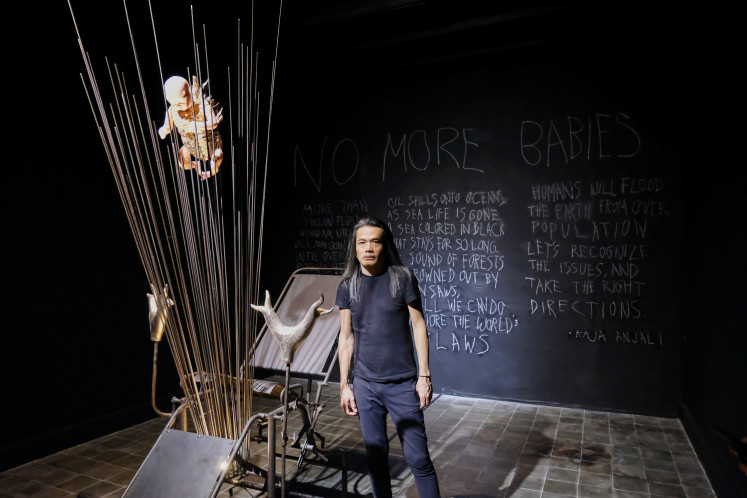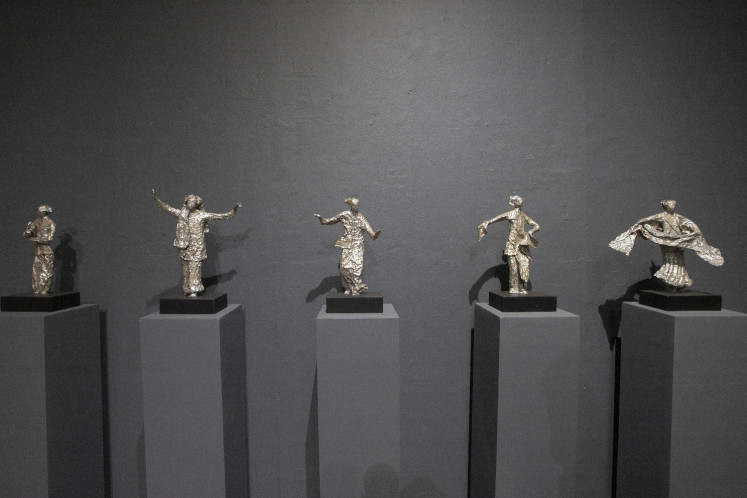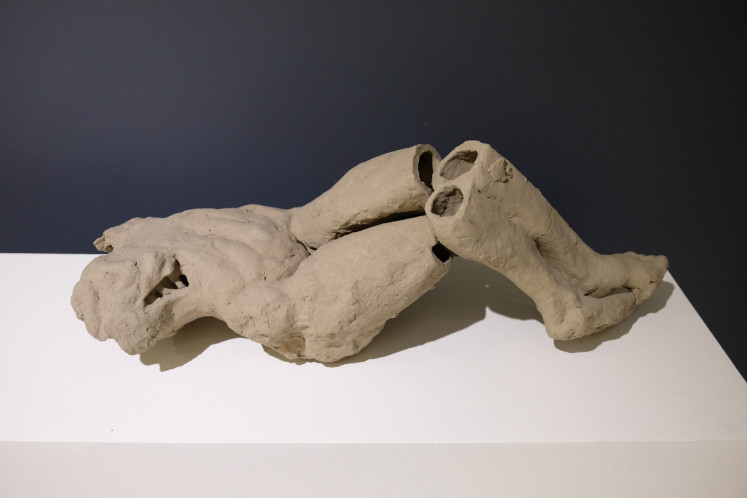Popular Reads
Top Results
Can't find what you're looking for?
View all search resultsPopular Reads
Top Results
Can't find what you're looking for?
View all search resultsARTJOG Festival puts forth inclusivity and solidarity
Change text size
Gift Premium Articles
to Anyone
W
ith the theme Expanding Awareness, the 2022 ARTJOG Festival highlights the work of artists from all walks of life, including the young and disabled, to emphasize inclusiveness and shared humanity.
The gold and soft PVC baby caught the attention of art lovers at the Jogja National Museum in Yogyakarta. Titled No More Babies, the work by Indonesian art director Jay Soebiyakto unsettled yet mesmerized viewers. The 62-year-old artist portrayed the infant in midair, skewered by dozens of steel rods between obstetrician gynecologists’ chairs dating from 1910.
“More than 7 billion people within our nations […] Humans will flood the earth from overpopulation,” he mused on the three-dimensional statue, which also touched on the seeming lack of statesmanship in contemporary Indonesia politics.
“Let’s recognize the issues, and take the right directions. No more babies, they belong in Nirvana.”
For Jay, whose highly acclaimed portfolio included stage works like Matah Ati, Laskar Pelangi the Musical and innumerable TV programs, No More Babies also seemed more relevant following the United States Supreme Court’s controversial decision to overturn Roe vs. Wade, a ruling which had, before the new ruling, guaranteed women’s abortion rights in the country.
Break free
No More Babies is among the works portrayed in the 2022 ARTJOG Festival, which is themed Expanding Awareness. The exhibition, which features the work of 61 new and veteran artists as well as art collectives across generations, is the third to be held since the COVID-19 pandemic struck in 2020.
“[ARTJOG’s] curatorial selection covers a spectrum that so far exists outside the 'mainstream' Indonesian arts, including art practiced by children, youth and disabled communities,” said ARTJOG curator Agung Hujatnikajennong.
“We believe that through art, it is possible to expand awareness not through a didactic, linear and unidirectional process, but cumulatively and reciprocally among the works of artists and audiences, so that the awareness about inclusiveness that we voice can also have a widespread impact, beyond the world of art."
Eminent Indonesian sculptor Dolorosa Sinaga, the artist representing this year’s festival, asserted that expanding awareness is half of what 2022 ARTJOG is all about.
"This year's [ARTJOG] theme cannot only be translated as 'Expanding Awareness', but must be interpreted as 'expanding concern'. After we experienced the COVID-19 pandemic, we, on the one hand, felt suffocated […] but on the other hand we became aware of the value of solidarity,” said the human rights activist and former dean of the Jakarta Arts Institute (IKJ).
“It encourages us to believe that art must be at the forefront of change.”
The dancers in Dolorosa’s aluminum-foil sculpture titled Batak Ritual Dance explored the notion of freedom from constraints imposed by COVID-19. Moving vibrantly to the dynamic movement of the collective Tor-Tor dance, a traditional dance from the Batak tribe in North Sumatra, the work aptly celebrated the loosening of lockdowns and other limits.
However, the 70-year-old artist also used the sculpture to double as a homage to her Batak heritage.
“Music and dance are an inseparable element from the rituals of Batak tradition -- whether [for] births, marriage or death,” Dolorosa noted in her description of Batak Ritual Dance. “The Tor-Tor Batak [dance] is the Batak people’s way of honoring their ancestors, who in turn taught the Batak to respect life.”
Up-and-coming artist Dzikra Afifah similarly took on the idea of breaking free with her ceramic works: Living Revelation Series, The Bardo and The Principal Within the Hollow. Restlessness and resignation alternated in the pieces, true to the Institute of Indonesian Arts and Culture alumnus in Sculpture’s intent to turn the medium inside-out.
“Conventional ceramics assimilate the shape of the body to show what is within through the hollowing process. The body will then be fired after hollowing, where it will show deformities typical to clay after the process,” Dzikra explained.
“However, I wish to convey the visceral, instinctive part of the work and its ties to nature as a source of life. [The COVID-19 pandemic’s] limitations on communal spaces also caused our sensibilities to be more individualistic.”
In contrast to Dolorosa’s Batak Ritual Dance, the torsos in The Bardo and The Principal Within the Hollow particularly touched on this premise. Disjointed, twisting and turning, they showed an urge to break free from lockdowns, social distancing and other constraints in the wake of the COVID-19 pandemic.
On the other hand, the severed legs in The Principal Within the Hollow showed how COVID-19 kept these impulses in check.
Dzikra’s sculptures made a profound impression. The 24-year-old is one of three ARTJOG Young Artist Award recipients, along with Rizka Azizah Hayati for her Magical Crocodile installation piece.
Video-artist Timoteus Anggawan Kusno rounded out the list with his multimedia-work Ghost Light.
Get inside out: Dzikra Afifah’s 'Principle Within the Hollow' takes viewers on a visceral journey through ceramics. (Courtesy of ARTJOG Festival) (Courtesy of ARTJOG Festival/Courtesy of ARTJOG Festival)Past cultural legacies reinterpretation
Artist Rizka Azizah Hayati is well-versed in the lore of her home district of Martapura, South Kalimantan. This includes the age-old legend of a supernatural crocodile guarding the river, a myth that she evoked with her installation piece Magical Crocodile, which is part of a bigger collection called the Manusia Sungai (River Human) Series.
The University of Malang major in Teaching Fine Arts deftly woven textile waste, rust dyeing and thread to convey the mystique of the supernatural, totemic creature.
“The mysticism and culture of the [Martapura] river and forests is rife with the locals’ collective memory for generations. Rizka’s ancestors have a tradition of taking care of a supernatural crocodile since their beginnings in Kalimantan’s Kalua district,” ARTJOG observed.
“The crocodile is believed to protect those who carry out trade along the river, and so is venerated with the title of datuk or lord. While the locals also use the legend of the magical crocodile to strike fear to the Dutch [colonizers], its primary purpose is to remind people living along the river banks to respect the stream.”
While Rizka's Magical Crocodile drew inspiration from age-old beliefs, artists Nano Warsono, Herman Priyono and others collaborated with the Jogja Disability Arts or JDA to recount the standing of disabled people in Indonesian society.
The result is Babad Disabilitas (Chronicle of the Disabled), a “visual and audiovisual narration on disabled people in Indonesian history and culture, especially in Java, from the ancient Mataram kingdom to [former Indonesian president Soeharto’s] New Order regime. [Babad Disabilitas] recounts the stance of those in power toward the disabled. These include their depictions on temple reliefs and the kraton in Yogyakarta,” said ARTJOG of the Jogja Disability Arts, which was founded in 2009.
“This is juxtaposed with a video of [Babad Disabilitas’] inception.”
The piece is marked by an audio of the Javanese-language Kidung Babad Wikara (The Chronicle of the Spoken Song) along with its text in Javanese and Braille. The chronicle is touched by the use of wayang (puppets) mediums such as Wayang Beber (puppets in stretched sheets of paper or cloth) and Wayang Gedhog (masked puppets) to recount the story of various disabled personalities.
The puppets include Bancak and Doyok, two visually impaired midgets who rose to become advisors to Raden (Prince) Panji Inu Kertapati of the ancient Javanese Janggala kingdom. It also features Banteng Wareng, the loyal adviser, bodyguard and follower of Prince Diponegoro during the latter’s uprising against the Dutch in the 19th century.
The JDA artists, among them chairman Sukri Budi Darma, Winda Karundhita, Zaka Nurul Giffani, Rofita Saru Rahayu, I Kadek Agus and Robby Agus Widodo, similarly overcame physical disabilities, deafness and blindness to bring the historical personages’ stories to life. But whichever work in ARTJOG piques your interest, you can be sure that they will expand your awareness of what life has to offer.
2022 ARTJOG Festival: Expanding Awareness is available until September 4, 2022 at Jogja National Museum, Jl. Soboman No.234 RT 06 DK.X, Ngestiharjo, Kasihan, Bantul, Daerah Istimewa Yogyakarta, Indonesia 55182.
Website: www.artjog.id














